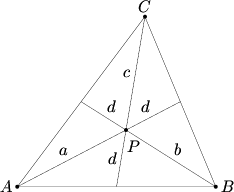Difference between revisions of "1988 AIME Problems/Problem 12"
(→Solution 2) |
(→Solution 2) |
||
| Line 27: | Line 27: | ||
Let the labels <math>A,B,C</math> be the weights of the vertices. First off, replace <math>d</math> with <math>3</math>. We see that the weights of the feet of the cevians are <math>A+B,B+C,C+A</math>. By mass points, we have that: <cmath>\dfrac{a}{3}=\dfrac{B+C}{A}</cmath> <cmath>\dfrac{b}{3}=\dfrac{C+A}{B}</cmath> <cmath>\dfrac{c}{3}=\dfrac{A+B}{C}</cmath> | Let the labels <math>A,B,C</math> be the weights of the vertices. First off, replace <math>d</math> with <math>3</math>. We see that the weights of the feet of the cevians are <math>A+B,B+C,C+A</math>. By mass points, we have that: <cmath>\dfrac{a}{3}=\dfrac{B+C}{A}</cmath> <cmath>\dfrac{b}{3}=\dfrac{C+A}{B}</cmath> <cmath>\dfrac{c}{3}=\dfrac{A+B}{C}</cmath> | ||
| − | If we add the equations together, we get < | + | If we add the equations together, we get <math>\frac{a+b+c}{3}=\frac{A^2B+A^2C+B^2A+B^2C+C^2A+C^2B}{ABC}=\frac{43}{3}</math> |
If we multiply them together, we get <math>\frac{abc}{27}=\frac{A^2B+A^2C+B^2A+B^2C+C^2A+C^2B+2ABC}{ABC}=\frac{49}{3} \implies abc=\boxed{441}</math> | If we multiply them together, we get <math>\frac{abc}{27}=\frac{A^2B+A^2C+B^2A+B^2C+C^2A+C^2B+2ABC}{ABC}=\frac{49}{3} \implies abc=\boxed{441}</math> | ||
| − | |||
| − | |||
== See also == | == See also == | ||
Revision as of 16:20, 18 September 2016
Contents
[hide]Problem
Let ![]() be an interior point of triangle
be an interior point of triangle ![]() and extend lines from the vertices through
and extend lines from the vertices through ![]() to the opposite sides. Let
to the opposite sides. Let ![]() ,
, ![]() ,
, ![]() , and
, and ![]() denote the lengths of the segments indicated in the figure. Find the product
denote the lengths of the segments indicated in the figure. Find the product ![]() if
if ![]() and
and ![]() .
.
Solution 1
Call the cevians AD, BE, and CF. Using area ratios (![]() and
and ![]() have the same base), we have:
have the same base), we have:
![]()
Similarily, ![]() and
and ![]() .
.
Then,
![]()
The identity ![]() is a form of Ceva's Theorem.
is a form of Ceva's Theorem.
Plugging in ![]() , we get
, we get
![]()
![]()
![]()
![]()
Solution 2
Let the labels ![]() be the weights of the vertices. First off, replace
be the weights of the vertices. First off, replace ![]() with
with ![]() . We see that the weights of the feet of the cevians are
. We see that the weights of the feet of the cevians are ![]() . By mass points, we have that:
. By mass points, we have that: ![]()
![]()
![]()
If we add the equations together, we get ![]()
If we multiply them together, we get ![]()
See also
| 1988 AIME (Problems • Answer Key • Resources) | ||
| Preceded by Problem 11 |
Followed by Problem 13 | |
| 1 • 2 • 3 • 4 • 5 • 6 • 7 • 8 • 9 • 10 • 11 • 12 • 13 • 14 • 15 | ||
| All AIME Problems and Solutions | ||
The problems on this page are copyrighted by the Mathematical Association of America's American Mathematics Competitions. 










